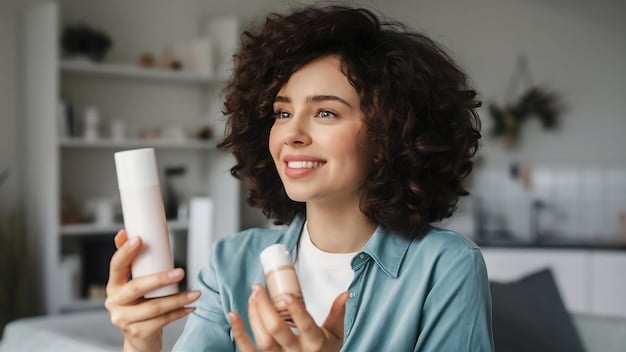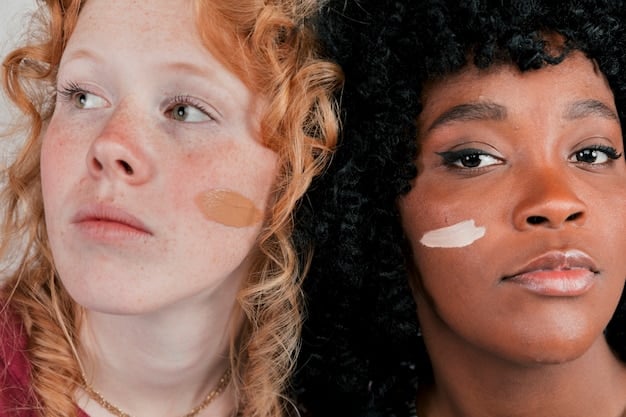The Ultimate Guide to Layering Skincare Products: Achieve Optimal Results by 2026

Layering skincare products correctly is essential for maximizing their effectiveness; this guide provides a step-by-step approach to layering, ensuring optimal absorption and visible results by January 2026.
Want to get the most out of your skincare routine? The Ultimate Guide to Layering Skincare Products: Achieve Optimal Absorption and Results by January 2026 is here to help you unlock the secrets to effective skincare application, ensuring you see real results.
Understanding the Basics of Skincare Layering
Skincare layering isn’t just about applying products one after another; it’s a strategic approach to ensure each product works synergistically to deliver maximum benefits. Understanding the underlying principles can significantly enhance your skincare routine’s effectiveness.
Why Layering Matters
Proper layering allows each product to penetrate the skin effectively, addressing specific concerns without interference. It’s about creating a customized routine that caters to your unique skin needs.
The Golden Rule: Thin to Thick
The general rule of thumb is to apply products from thinnest to thickest consistency. This ensures that lighter, water-based products are absorbed first, followed by heavier, oil-based products.
- Water-based serums: Applied first to deliver active ingredients directly to the skin.
- Light lotions: Hydrate the skin without creating a barrier.
- Creams and oils: Seal in moisture and provide a protective layer.
- SPF: Always the final step in the morning to shield the skin from harmful UV rays.
By following this order, you prevent thicker products from blocking the absorption of thinner ones, ensuring that each product can perform its intended function effectively.
Step-by-Step Guide to Layering Your Skincare Products
Now that you understand the basics, let’s dive into the specific steps for layering your skincare products. This section will provide a clear, actionable routine to help you optimize your skincare regimen.
Morning Skincare Routine
Your morning routine should focus on protecting your skin from environmental stressors. A simple, effective layering approach will set you up for the day.

- Cleanser: Start with a gentle cleanser to remove any overnight buildup.
- Toner: Balance your skin’s pH and prepare it for the next steps.
- Serum (Vitamin C): Apply a Vitamin C serum for antioxidant protection.
- Moisturizer: Hydrate your skin and create a smooth base.
- Sunscreen: The most crucial step to protect your skin from UV damage.
Evening Skincare Routine
Your evening routine should focus on repair and hydration. It’s the perfect time to use more potent ingredients that work while you sleep.
- Makeup Remover: Start by removing all traces of makeup.
- Cleanser: Cleanse your skin to remove dirt and oil.
- Exfoliant (1-2 times per week): Use a chemical exfoliant to remove dead skin cells. (Use 1-2 times per week)
- Serum (Hyaluronic Acid/Retinol): Apply serums with hydrating or anti-aging benefits.
- Moisturizer: Lock in hydration with a richer cream.
Remember to listen to your skin and adjust the routine based on your individual needs. If you experience irritation, reduce the frequency of certain products.
The Importance of Product Compatibility
Not all skincare ingredients play well together, and understanding which products to pair and which to avoid is essential for preventing irritation and maximizing benefits.
Ingredients That Work Well Together
Some ingredients enhance each other’s effectiveness when used together. Knowing these combinations can boost your routine.
- Vitamin C and Sunscreen: Vitamin C boosts sunscreen’s protective effects.
- Retinol and Hyaluronic Acid: Hyaluronic acid can help mitigate the drying effects of retinol.
- AHAs/BHAs and Moisturizers: Exfoliants can be drying, so pairing them with a moisturizer is crucial.
Ingredients to Avoid Combining
Combining certain ingredients can lead to irritation or reduced effectiveness. Here are some pairings to avoid.
Avoid mixing highly active ingredients, such as retinol with AHAs/BHAs, in the same routine to prevent irritation and over-exfoliation.
- Retinol and Vitamin C: Can destabilize each other and cause irritation.
- AHAs/BHAs and Retinol: Can be too harsh and lead to excessive dryness and peeling.
- Benzoyl Peroxide and Retinol: Can deactivate retinol and cause irritation.
By understanding these interactions, you can avoid common skincare mistakes and create a routine that’s both effective and gentle on your skin.
Tailoring Your Routine to Your Skin Type
Everyone’s skin is unique, and what works for one person may not work for another. Tailoring your skincare layering routine to your specific skin type is crucial for achieving the best results.
For Dry Skin
Dry skin needs extra hydration and moisture. Focus on products that replenish and lock in hydration.
- Hydrating Cleanser: Look for creamy, non-foaming cleansers.
- Hyaluronic Acid Serum: Attracts and retains moisture in the skin.
- Rich Moisturizer: Use a thick cream with emollients and occlusives.
- Facial Oil: Seal in moisture and provide an extra layer of protection.
For Oily Skin
Oily skin needs lightweight products that won’t clog pores. Focus on oil control and balancing hydration.

If you have oily skin, use light moistrizers and oil control products.
- Gel Cleanser: Removes excess oil without stripping the skin.
- BHA Toner: Exfoliates and unclogs pores.
- Lightweight Serum: Choose a serum with ingredients like niacinamide for oil control.
- Oil-Free Moisturizer: Hydrates without adding extra oil.
- Mattifying Sunscreen: Controls shine and protects from UV rays.
For Sensitive Skin
Sensitive skin needs gentle, fragrance-free products. Focus on soothing and calming ingredients.
If you have sensitive skin, use gentle, fragrance-free products that have soothing ingredients.
- Gentle Cleanser: Free of harsh sulfates and fragrances.
- Soothing Toner: Look for ingredients like aloe vera or chamomile.
- Calming Serum: Choose a serum with ingredients like niacinamide or centella asiatica.
- Simple Moisturizer: Avoid potential irritants like fragrances and dyes.
- Mineral Sunscreen: Less likely to cause irritation than chemical sunscreens.
By understanding your skin type and choosing products accordingly, you can create a layering routine that addresses your specific needs and concerns.
Common Mistakes to Avoid When Layering Skincare
Even with the best intentions, it’s easy to make mistakes when layering skincare products. Avoiding these common pitfalls can significantly improve your results.
Using Too Many Products
Overloading your skin with too many products can lead to irritation and reduced effectiveness. Stick to a streamlined routine with essential products.
A minimalist approach often yields better results than a complex one. Focus on key ingredients that address your main concerns.
Applying Products in the Wrong Order
Applying products out of order can prevent proper absorption. Always follow the thin-to-thick rule.
Ensure that water-based products are applied before oil-based ones to maximize their effectiveness.
Not Allowing Enough Time for Absorption
Rushing through your skincare routine can prevent products from fully absorbing. Allow a few minutes between each layer.
Patience is key to allowing each product to penetrate the skin properly. Use this time to massage the products in gently.
Achieving Optimal Results by January 2026
To achieve optimal skin health and visible improvements by January 2026, consistency and patience are key. Building a solid skincare layering routine now can set you up for long-term success.
Skincare is a marathon, not a sprint. Commit to a consistent routine and track your progress over time.
- Consistency: Stick to your routine every day for optimal results.
- Patience: It takes time to see visible improvements, so be patient and persistent.
- Adjustment: Be willing to adjust your routine as your skin’s needs change.
- Professional Advice: Consult a dermatologist for personalized recommendations.
By following these guidelines, you can create a skincare layering routine that delivers real results and helps you achieve your skincare goals by January 2026.
| Key Point | Brief Description |
|---|---|
| 💧 Thin to Thick | Apply products from thinnest to thickest for optimal absorption. |
| ☀️ Morning Routine | Focus on protection with Vitamin C and sunscreen. |
| 🌙 Evening Routine | Focus on repair with retinols and deep hydration. |
| 🚫 Combine Wisely | Avoid mixing ingredients like retinol and AHAs to prevent irritation. |
FAQ: Skincare Layering
▼
The general rule is to apply products from thinnest to thickest consistency: cleanser, toner, serum, moisturizer, and sunscreen in the morning; makeup remover, cleanser, exfoliant, serum, and moisturizer in the evening.
▼
Layering skincare products allows each product to penetrate the skin effectively, addressing specific concerns without interference. It maximizes the efficacy of your skincare routine and boosts results.
▼
Avoid mixing highly active ingredients, such as retinol with AHAs/BHAs, in the same routine to prevent irritation and over-exfoliation. Mixing Vitamin C and retinol can also cause irritation.
▼
Exfoliate 1-2 times per week, depending on your skin type and sensitivity. Over-exfoliating can lead to dryness, irritation, and inflammation, so be gentle and pay attention to your skin’s needs.
▼
Yes, you can layer multiple serums. Apply them from thinnest to thickest or based on their active ingredients. For example, apply water-based serums before oil-based serums and serums with antioxidants before those with retinol.
Conclusion
Mastering the art of skincare layering requires understanding the basics, choosing compatible products, tailoring your routine to your skin type, and avoiding common mistakes. By following this guide, you can create a skincare routine that delivers optimal results and helps you achieve your skincare goals by January 2026.





